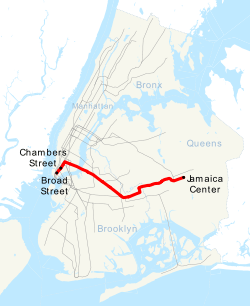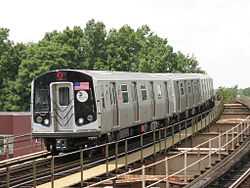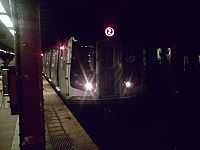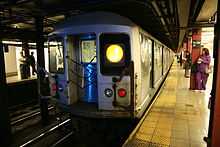J/Z (New York City Subway service)
| Nassau Street Local/Express | |
|---|---|
  | |
 | |
| Northern end | Jamaica Center – Parsons/Archer |
| Southern end |
Broad Street (weekdays) Chambers Street (weekends) |
| Stations |
30 (J service) 21 (Z service) |
| Rolling stock | R32, R42, R160 |
| Depot | East New York Yard |
The J and Z Nassau Street Local/Express[1] (earlier Jamaica Express and displayed as Jamaica Local/Express on the R160 cars) are two rapid transit services in the B Division of the New York City Subway. Their route emblems, or "bullets", are colored terra cotta brown since they use the BMT Nassau Street Line in Lower Manhattan.[2] The J always runs while the Z operates only during rush hours in the peak direction; both services use the entire BMT Archer Avenue, Jamaica, and Nassau Street lines between Jamaica Center – Parsons/Archer, in Jamaica, Queens, and Lower Manhattan (via the Williamsburg Bridge between Brooklyn and Manhattan). On weekdays, trains run express in Brooklyn between Myrtle Avenue and Marcy Avenue in the peak direction, bypassing three stations. During rush hours also in the peak direction, the J and Z form a skip-stop pair east of Myrtle Avenue. During weekdays, the J and Z run to/from the southernmost station on the Nassau Street Line, Broad Street. On weekends, the J is cut back to/from Chambers Street; however, the MTA is making it run its full route during that time period, starting in mid-2015.[3] Currently, Broad Street and Fulton Street are two of the four stations that are not served full-time (the others being the two stations of the IRT 42nd Street Shuttle).
History


Before the Chrystie Street Connection
The Jamaica Line – then known as the Broadway Elevated – was one of the original elevated lines in Brooklyn, completed in 1893 from Cypress Hills west to Broadway Ferry in Williamsburg.[4] It was then a two-track line, with a single local service between the two ends, and a second east of Gates Avenue, where the Lexington Avenue Elevated merged.[5] This second service later became the 12, and was eliminated in 1950 with the abandonment of the Lexington Avenue el.
The second major service on the Broadway Elevated ran between Canarsie and Williamsburg via the BMT Canarsie Line, started on July 30, 1906, when the Broadway and Canarsie tracks were connected at East New York.[6] As part of the Dual Contracts, an extension from Cypress Hills east to Jamaica was completed on July 3, 1918,[7] a third track was added west of East New York, and express trains began running on it in 1922.
The Brooklyn–Manhattan Transit Corporation numbered its services in 1924, and the Canarsie and Jamaica services became 14 and 15. Both ran express during rush hours in the peak direction west of East New York, and additional 14 trains, between Eastern Parkway or Atlantic Avenue on the Canarsie Line and Manhattan provided rush-hour local service on Broadway.[8] When the 14th Street–Eastern Line and Canarsie Line were connected on July 14, 1928,[9] the old Canarsie Line service was renamed the Broadway (Brooklyn) Line, providing only weekday local service over the Broadway Elevated west of Eastern Parkway. The Atlantic Avenue trips remained, and rush-hour trains continued to serve Rockaway Parkway (Canarsie), though they did not use the Broadway express tracks.[10] The 14 was later cut back to only rush-hour service.
On the Manhattan end, the first extension was made on September 16, 1908, when the Williamsburg Bridge subway tracks opened.[11] Broadway and Canarsie trains were extended to the new Essex Street terminal, and further to Chambers Street when the line was extended on August 4, 1913.[12] When the BMT Nassau Street Line was completed on May 30, 1931, the 15 was extended to Broad Street,[13][14] and the 14 was truncated to Canal Street.[10] Some 14 trains began terminating at Crescent Street on the Jamaica Line in 1956.

| |
R32 end rollsign |
Inbound rush hour skip-stop service between Jamaica and East New York was implemented on June 18, 1959.[15] Express 15 trains served "A" stations, while the morning 14 became the Jamaica Local, running between Jamaica and Canal Street, and stopped at stations marked "B".[16] These stations were as follows:[17]
- All trains: 168th Street • Sutphin Boulevard • Elderts Lane • Eastern Parkway
- "A" stations: 168th Street • Sutphin Boulevard • 121st Street • 111th Street • Woodhaven Boulevard • 85th Street – Forest Parkway • Elderts Lane • Crescent Street • Cleveland Street • Eastern Parkway
- "B" stations: 168th Street • 160th Street • Sutphin Boulevard • Queens Boulevard • Metropolitan Avenue • 104th Street • Elderts Lane • Cypress Hills • Norwood Avenue • Van Siclen Avenue • Alabama Avenue • Eastern Parkway
Letters were assigned to most BMT services in the early 1960s. The BMT Jamaica services retained their numbers until November 1967. The 15 became the J (express), and the 14 became the JJ.[18]
Chrystie Street Connection to 1976
When the Chrystie Street Connection opened on November 26, 1967, many services were changed. The two local services - the JJ (non-rush hours) and KK (rush hours) - were combined as the JJ, but without any major routing changes. Thus non-rush hour JJ trains ran between Jamaica and Broad Street, while morning rush hour JJ trains ran to Canal Street, and afternoon rush hour JJ trains ran between Canal Street and Atlantic Avenue or Crescent Street. The rush-hour express J was combined with the weekday QT Brighton Local via tunnel to form the weekday QJ, running between Jamaica and Brighton Beach via the Jamaica Line (express during rush hours in the peak direction), BMT Nassau Street Line, Montague Street Tunnel, and BMT Brighton Line (local). Finally, the RJ was a special peak-direction rush-hour service, running fully local on the Jamaica Line, Nassau Street Line, Montague Street Tunnel, and BMT Fourth Avenue Line to 95th Street in Fort Hamilton. This was an extension of a former rush-hour RR service, and thus ran towards Jamaica in the morning and towards Fort Hamilton in the afternoon.[19]
The next change was made on July 1, 1968, when the Chrystie Street Connection tracks to the Williamsburg Bridge opened. The Jamaica Line portion of the rush-hour JJ was modified to become a new rush-hour KK, running between Jamaica (peak direction) or Eastern Parkway (both directions) and the new 57th Street station on the IND Sixth Avenue Line in Manhattan. The MM (with a dark green bullet on R-27 signage) was a proposed alternative to the KK as a local to 57th Street/6th Avenue, which finally opened in July, 1968.[20]The RJ was eliminated, being cut back to an RR variant, and the off-hour JJ was relabeled QJ (but not extended to Brighton Beach). At the same time, the existing skip-stop service was extended to afternoon Jamaica-bound trains, with those QJ trains running express west of Eastern Parkway and service "A" stations east to Jamaica, and those KK trains serving "B" stations. Less than two months later, on August 18, the QJ was extended to Coney Island – Stillwell Avenue.[21][22]
These new services were slowly eliminated in the 1970s due to financial problems. First, on January 6, 1974, the QJ was cut back full-time to Broad Street and redesignated the J; the M was extended to Coney Island in its place. At the same time, the KK was cut back to Eastern Parkway and renamed the K,[23] and both skip-stop patterns were carried out by alternate J trains. Eventually, the K was discontinued entirely on August 30, 1976,[24] eliminating the J skip-stop and express service east of Myrtle Avenue. (One-way express service remained west of Myrtle Avenue, since the M was switched to the local tracks at that time.)
The following table summarizes the changes that were made between 1959 and 1976.
| Morning rush-hour local | Morning rush-hour express | Afternoon rush-hour local | Afternoon rush-hour express | Other local | Other service | |
|---|---|---|---|---|---|---|
| 1959–67 | 14/KK 168th Street - Canal Street, "B" stops inbound | 15/J 168th Street - Broad Street, "A" stops inbound | 14/KK Crescent Street, Atlantic Avenue, or Rockaway Parkway - Canal Street | 15/J 168th Street - Broad Street | 15/JJ 168th Street - Broad Street | |
| 1967–68 | JJ 168th Street - Canal Street, "B" stops inbound | QJ 168th Street - Brighton Beach, "A" stops inbound | JJ Crescent Street or Atlantic Avenue - Canal Street | QJ 168th Street - Brighton Beach | JJ 168th Street - Broad Street QJ 168th Street - Brighton Beach, middays and early evenings |
RJ 168th Street - Bay Ridge, rush hour non-peak direction only |
| 1968–1974 | KK 168th Street - 57th Street, "B" stops inbound | QJ 168th Street - Brooklyn, "A" stops inbound | KK 168th Street - 57th Street, "B" stops outbound | QJ 168th Street - Brooklyn, "A" stops outbound | QJ 168th Street - Broad Street or Brooklyn | |
| 1974–1976 | K Eastern Parkway - 57th Street | J 168th Street - Broad Street, two inbound patterns, one for "A" stops and one for "B" stops | K Eastern Parkway - 57th Street | J 168th Street - Broad Street, two outbound patterns, one for "A" stops and one for "B" stops | J 168th Street - Broad Street |
1976 to present
The J was truncated to Queens Boulevard just after midnight on September 11, 1977,[25] and to 121st Street on April 15, 1985,[26] concurrent with the cutting-back of the Jamaica Line. The Q49 shuttle bus replaced the train until 1988.
The BMT Archer Avenue Line opened on December 11, 1988, extending the line back east from 121st Street. The Z train first ran that day, introducing the present J/Z skip-stop pattern.[27] The new Z trains would go skip-stop between Jamaica Center and Broadway Junction (later Myrtle Avenue) during rush hours. Bus service on several Queens bus routes was rerouted to go to Jamaica Center – Parsons/Archer instead of to 169th Street The J/Z service was touted as being faster to lower Manhattan than E, F, and R service, in an attempt to relieve some crowding on the IND Queens Boulevard Line; as the MTA hoped that Queens passengers would transfer to the J/Z from the E, F, and R, every subway car on the J and Z 's fleet was completely graffiti-free.[28]
In 1990, weekend service terminated at Canal Street, but was then extended back to Chambers Street in 1994.
From April 30 to September 1, 1999, the Williamsburg Bridge was closed for reconstruction. J trains ran only between Jamaica Center – Parsons Archer and Myrtle Avenue. J/Z skip-stop service was in both directions between Jamaica Center and Eastern Parkway-Broadway Junction.
After the 2001 September 11 attacks, R service was suspended. J trains were extended beyond Broad Street via the Montague Street Tunnel to replace the R to Bay Ridge – 95th Street at all times except late nights, when it only ran to Broad Street and a shuttle ran in Brooklyn between 95th and 36th Streets. J/Z skip-stop service was suspended.[29] Normal service on all three trains was restored on October 28.[30]
On July 2014, a proposal was made to extend weekend J service back to Broad Street to allow easier access to Brooklyn, starting in mid-2015.[31][3] It was to be discussed in front of the public on the week of July 31, 2014.[32]
Route
Service pattern
The following table shows the lines used by the J and Z services, with shaded boxes indicating the route at the specified times:
| Line | From | To | Tracks | Times | ||||
|---|---|---|---|---|---|---|---|---|
| |
| |||||||
| mid- days |
even- ings |
week- ends |
rush peak |
rush peak | ||||
| BMT Archer Avenue Line | Jamaica Center | Sutphin Boulevard | all | |||||
| BMT Jamaica Line | 121st Street | Myrtle Avenue | local (all) | |||||
| local (skip-stop) | ||||||||
| Myrtle Avenue | Marcy Avenue | local | ||||||
| express | ||||||||
| Williamsburg Bridge | all | |||||||
| BMT Nassau Street Line | Essex Street | Chambers Street | ||||||
| Fulton Street | Broad Street | |||||||
Stations
For a more detailed station listing, see the articles on the lines listed above.
| Station service legend | |
|---|---|
| |
Stops all times |
| |
Stops all times except late nights |
| |
Stops late nights only |
| |
Stops weekdays only |
| |
Stops all times except rush hours in the peak direction |
| |
Stops rush hours in the peak direction only |
| |
No available service |
| Time period details | |
References
- ↑ "J/Z Subway Timetable, Effective December 7, 2014" (PDF). New York Metropolitan Transportation Authority. Retrieved 2015-01-02.
- ↑ "mta.info - Line Colors". mta.info.
- ↑ 3.0 3.1 "MTA - news - MTA’s Proposed 2015 Budget Includes Systemwide Service Enhancements". mta.info.
- ↑ "Trains Running This Morning". Brooklyn Daily Eagle (Brooklyn, NY). May 30, 1893. p. 10.
- ↑ "Better Service on the Brooklyn L". Brooklyn Daily Eagle (Brooklyn, NY). December 20, 1893. p. 12.
- ↑ "The BRT Opens Its New Extension for Through Traffic". The New York Times. July 31, 1906. p. 12. Retrieved 2010-03-20.
- ↑ "New Subway Line". The New York Times. July 7, 1918. p. 30. Retrieved 2010-03-20.
- ↑ Brooklyn–Manhattan Transit Corporation, Map and Guide to BMT Rapid Transit Division, 1924
- ↑ "Celebrate Opening of New B. M. T. Line". The New York Times. July 15, 1928. p. 13. Retrieved 2010-03-20.
- ↑ 10.0 10.1 Brooklyn–Manhattan Transit Corporation, Map and Guide to BMT Rapid Transit Division, 1931
- ↑ "Mayor Runs a Train Over New Bridge". The New York Times. September 17, 1908. p. 16. Retrieved 2010-03-20.
- ↑ "Bridge Loop to Open for One Line Only". The New York Times. August 3, 1913. p. 6. Retrieved 2010-03-20.
- ↑ "Nassau St. Service Outlined by B. M. T.". The New York Times. May 21, 1931. p. 29. Retrieved 2010-03-20.
- ↑ "Mayor Drives Train in New Subway Link". The New York Times. May 30, 1931. p. 11. Retrieved 2010-03-20.
- ↑ "Jamaica BMT to Start Speed-Up Tomorrow". The New York Times. June 17, 1959. p. 28. Retrieved 2010-03-20.
- ↑ New York City Transit Authority, Official New York City Subway Map and Station Guide, 1959
- ↑ New York City Transit Authority, Skip Stop on the BMT Jamaica Line, 1959
- ↑ Joseph Cunningham and Leonard DeHart, A History of the New York City Subway System Part 2: Rapid Transit in Brooklyn, 1977
- ↑ New York City Transit Authority, New York City Rapid Transit Map and Station Guide, 1967
- ↑ "THANK YOU FOR YOUR SERVICE Retired line designations Page 2". forgotten-ny.com.
- ↑ New York City Transit Authority, Rapid Transit Service Changes, 1968
- ↑ New York City Transit Authority, KK - a new service, 1968
- ↑ "Subway Schedules In Queens Changing Amid Some Protest". The New York Times. January 2, 1973. p. 46. Retrieved 2010-03-20.
- ↑ "Transit Agency Drops 215 Runs". The New York Times. August 31, 1976. p. 42. Retrieved 2010-03-20.
- ↑ Dembart, Lee (September 9, 1977). "A Sentimental Journey on the BMT...". The New York Times. p. 61. Retrieved 2010-03-20.
- ↑ "www.nycsubway.org". www.nycsubway.org.
- ↑ Johnson, Kirk (December 9, 1988). "Big Changes For Subways Are to Begin". The New York Times. p. B1. Retrieved 2010-03-20.
- ↑ nycsubway.org—The New York Transit Authority in the 1980s
- ↑ "www.nycsubway.org". nycsubway.org.
- ↑ "www.nycsubway.org". nycsubway.org.
- ↑ "mta.info - 2014 - 2017 MTA Financial Plan". mta.info.
- ↑ http://www.nydailynews.com/new-york/train-service-upgrade-part-mta-new-financial-plan-article-1.1878079
External links
|
- MTA NYC Transit – J Nassau Street Express
- MTA NYC Transit – Z Nassau Street Express
- "J/Z Subway Timetable, Effective December 7, 2014" (PDF). New York Metropolitan Transportation Authority. Retrieved 2015-01-02.
| ||||||||||||||||||||||||||||||||||||||||||||||||||




